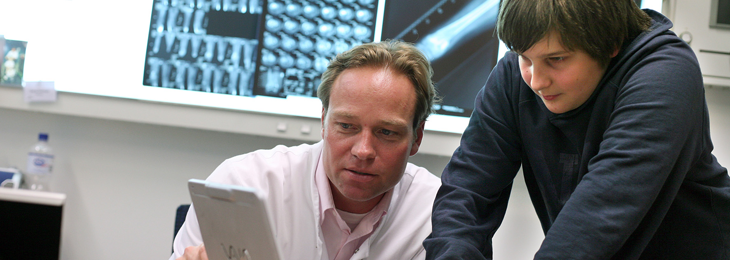Conventional chondrosarcoma
Conventional chondrosarcoma is the second most common primary malignant bone tumors. Contrary to osteosarcoma and Ewing sarcoma, chondrosarcoma usually affects adult patients, and more than 70% of all patients are older than 40 years. The majority of the tumors are localized in the pelvis, followed by the upper part of the femur, the upper part of the humerus, the lower part of the femur and the ribs.
Conventional chondrosarcomas can have a low, intermediate or high malignancy grade. The grade of malignancy is the single most important predictor of the probability of survival. Most chondrosarcomas are low-grade tumors, intermediate grade chondrosarcomas make out a third of all tumors, while high-grade tumors are rarer.
The surgical treatment of chondrosarcomas depends on the tumor grade, extent and localization. Low-grade tumors in the extremities without a soft tissue component can be adequately treated with a meticulous curettage, followed by burr drilling and plombage with polymethyl methacrylate cement. For all other tumors, the local treatment of choice is surgical excision of the entire tumor surrounded by a layer of healthy tissue, which is considered to be a prerequisite for long-term survival. In specialized centers this can be achieved in the vast majority of patients by limb-salvage surgery – meaning that the tumor can be adequately excised without compromising the function of the affected extremity.
Following the excision of most chondrosarcomas, it is necessary to reconstruct the resulting defect. The most common form of reconstruction is endoprosthetic replacement, which involves implanting specialized metallic megaprostheses. The choice of the optimal implant and the of the optimal reconstruction method depends on several factors, such as tumor site and extension, as well as patient age, activity level and expected prognosis. For that reason the treating surgeon should be proficient in several different reconstruction options.
Conventional chondrosarcomas are considered to be resistant to standard chemotherapy and radiotherapy. However, patient with rare histological chondrosarcoma subtypes or metastatic disease might benefit from such treatment optiones. An extensive experience in the interdisciplinary treatment of chondrosarcoma is required to administer the best possible treatment to each patient.


